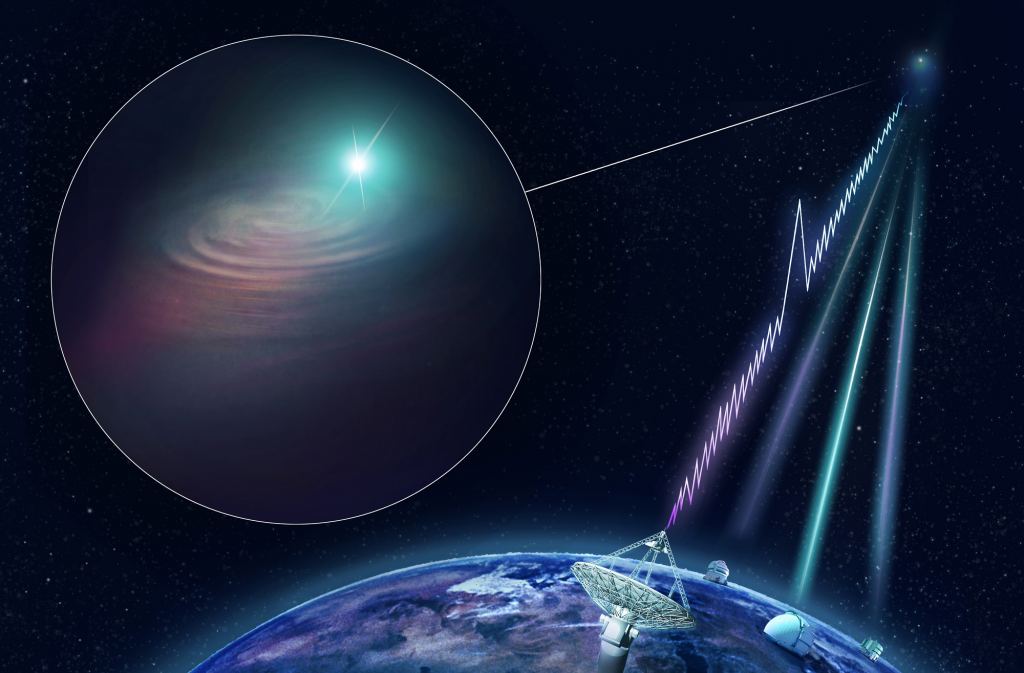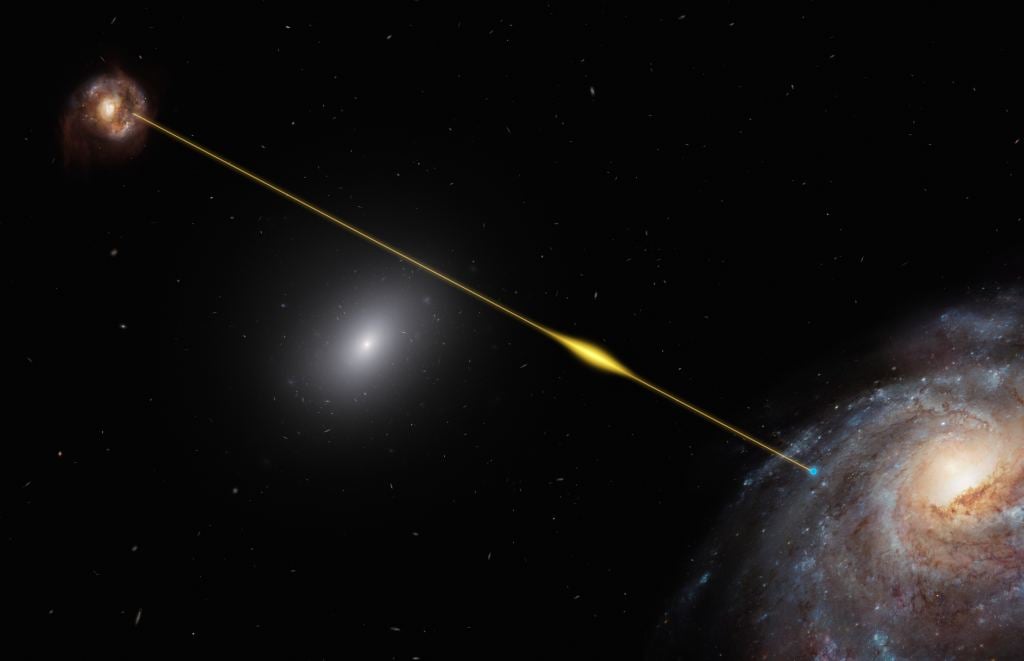Much like Dark Matter and Dark Energy, Fast Radio Burst (FRBs) are one of those crazy cosmic phenomena that continue to mystify astronomers. These incredibly bright flashes register only in the radio band of the electromagnetic spectrum, occur suddenly, and last only a few milliseconds before vanishing without a trace. As a result, observing them with a radio telescope is rather challenging and requires extremely precise timing.
Hence why the Dominion Radio Astrophysical Observatory (DRAO) in British Columbia launched the Canadian Hydrogen Intensity Mapping Experiment (CHIME) in 2017. Along with their partners at the National Radio Astronomy Observatory (NRAO), the Massachusetts Institute of Technology (MIT), the Perimeter Institute, and multiple universities, CHIME detected more than 500 FRBs in its first year of operation (and more than 1000 since it commenced operations)!
To recap, astronomers have only been studying FRBs since 2007 when the first event was reported. Prior to mid-2017 when CHIME became operational, only about two dozen had ever been observed and their origin remains unknown. However, it has since been learned that as cosmological phenomena go, they are ubiquitous, with thousands of events arriving at Earth every day from every corner of the sky.
CHIME's Mission
Originally conceived to map the distribution of hydrogen over much of the observable universe, the novel design of CHIME also makes it highly effective for the study of FRBs. In addition to being stationary with no moving parts, it is optimized for high "mapping speed," thanks to its large instantaneous field of view (~200 square degrees) and broad frequency coverage - 400 to 800 megahertz (MHz).
While most radio astronomy is performed using large dish antennas that focus light from different parts of the sky, CHIME is motionless and focuses incoming signals onto its four massive cylindrical radio antennas. The telescope also relies on a powerful digital signaling processor (aka. correlator) that is capable of sorting through data at a rate of about 7 terabits per second - a small percent of the world's internet traffic.
Since it became operational, CHIME has nearly quadrupled the total number of FRBs that have been detected. In its first year of operation (between 2018 and 2019), it detected 535 new FRBs. After mapping the timing and locations, scientists found that the bursts were evenly distributed in space and occur at a rate of about 800 per day, which is the most precise estimate of the overall rate of FRBs to date.
As Kiyoshi Masui, a member of MIT's Kavli Institute for Astrophysics and Space Research, explained in an MIT press release:
“That’s kind of the beautiful thing about this field — FRBs are really hard to see, but they’re not uncommon. If your eyes could see radio flashes the way you can see camera flashes, you would see them all the time if you just looked up.”
New Events and Insights
These were assembled in the telescope's first FRB catalog, which was presented last week at the 238th American Astronomical Society Meeting (AAS), a virtual event that ran from June 7th to 9th. The new catalog expands the current library of known FRBs and is already leading to new insights about their properties and possible causes. In particular, the catalog is informing astronomers about the difference between the two distinct classes of FRBs.
These include FRBs that repeat and those that are a one-off occurrence. Whereas one-off bursts are believed to be entirely natural in occurrence, repeating FRBs defy conventional explanation. There are even some that think that repeating bursts could be a possible technosignature - i.e., an indication of extraterrestrial intelligence. To date, only 18 FRBs have been reported that burst repeatedly, whereas the rest appear to be singular in nature.
The repeating FRBs also differ in that they last slightly longer than non-repeating ones, and emit more focused radiofrequency bursts. What this suggests is that those FRBs that repeat and those that don't have different mechanisms and astrophysical sources. This is an important step in resolving what causes these enigmatic bursts and something astronomers hope to build upon soon.
As Kaitlyn Shin, a graduate student in MIT's Department of Physics and a member of the CHIME Collaboration, said in a recent MIT press release:
“Before CHIME, there were less than 100 total discovered FRBs; now, after one year of observation, we’ve discovered hundreds more. With all these sources, we can really start getting a picture of what FRBs look like as a whole, what astrophysics might be driving these events, and how they can be used to study the universe going forward."
Mapping the Cosmos
Another benefit to all these recorded events is the way they will allow astronomers and cosmologists to gain a better understanding of the structure and distribution of matter in the Universe. The reason is that as radio waves travel across space, they pass through the dust and gas that permeate interstellar and intergalactic space. This can distort or disperse the properties and trajectory of radio waves, the degree of which can
The degree to which a radio wave is dispersed can give clues to how much gas it passed through, and possibly how much distance it has traveled from its source. From each of the 535 FRBs that CHIME detected, Masui and his colleagues measured the dispersion and found that most bursts likely originated in distant galaxies. The fact that they were bright enough to be detected by CHIME suggests that they must have been produced by very energetic sources.
As CHIME and other radio observatories detect more FRBs, scientists hope to pin down exactly what kind of exotic and powerful phenomenon causes them. They also hope to use them to create more detailed maps of the cosmos. As Shin summarized:
“Each FRB gives us some information of how far they’ve propagated and how much gas they’ve propagated through. With large numbers of FRBs, we can hopefully figure out how gas and matter are distributed on very large scales in the universe. So, alongside the mystery of what FRBs are themselves, there’s also the exciting potential for FRBs as powerful cosmological probes in the future.”
This research was supported provided by the Canada Foundation for Innovation (CFI), the Dunlap Institute for Astronomy and Astrophysics, the Canadian Institute for Advanced Research (CIFAR), the McGill Space Institute (MSI), the Trottier Family Foundation, and the University of British Columbia (UBC).
Further Reading: MIT News
 Universe Today
Universe Today


